
views
- Grind the blade by dragging it against a whet stone.
- Use a honing rod to hone the blade after every usage. This will limit the number of times you need to sharpen the blade.
- In a pinch, use a ceramic coffee mug to grind your blade: flip the mug over and drag the blade against the rough edge of the mug’s bottom.
- Always wipe down your blade after grinding or honing to eliminate any steel residue.
Using a Whetstone

Apply honing oil or water to your stone, if appropriate. Check your manufacturer's guidelines to see if your sharpening stone needs to be lubricated, and with what. Depending on what type of sharpening stone you’re using, it may need to be lubricated with oil or water, or with nothing at all. Cover the whole stone with the lubricant and keep it wet while you sharpen your knife. Lubrication will make it easier for the blade to pass over the stone, as well as keep the steel shavings (the by-product of sharpening) from clogging the stone's pores. If you don’t have honing oil, you can use mineral oil, vegetable oil, or window cleaner as a substitute.

Determine what angle to sharpen your knife. Sharpen your knife at the same angle it was previously sharpened at. To find out the angle of your blade, ask the manufacturer of your knife or inquire at a knowledgeable knife shop to determine what angle is appropriate for your knife. If you have to make a gut decision, choose an angle of 10° - 30° per side. Shallower angles make a sharper edge that doesn't last as long; steeper angles are more durable, so 15° - 20° is a good compromise between the two. Sharpening at a different angle will take significantly more time and may take a few goes before any rough angles are smoothed out.
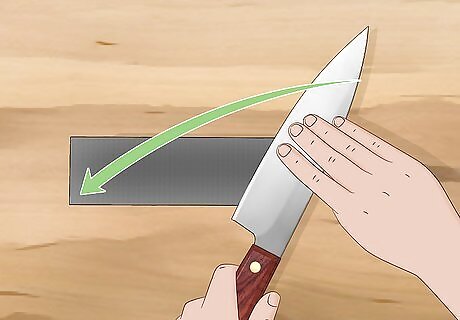
Draw the blade across the rough side of the stone. Drag with the blade edge toward the stone, rather than away, as if you might shave off the top layer of the stone. Apply only light pressure here, beginning with the base of the knife (also called the heel) and ending at the tip, and make sure to maintain your 20° angle. Dragging the knife this way will help your blade to maintain a symmetrical edge and allow a burr to form on the stone and prolong the stone's life. In general, whetstones have different grits on either side. Check the grit on your stone, or the packaging that came with the stone, to identify which side is which. To estimate a 20° angle, use an angle guide.
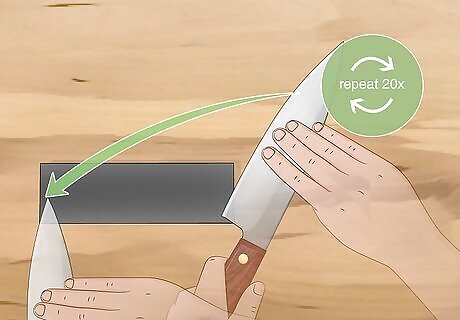
Repeat this motion about 20 times on each side of your blade. Alternating between sides of your blade is important to ensure you sharpen the blade evenly. Draw the blade against the stone 10 times on each side, then 5 times, then 3 times, then alternate single strokes back and forth 6 times. Stop when you’ve raised a burr on the knife’s edge—a feature that steel will naturally form when one bevel is ground until it meets another. You can test to see if a burr has formed by applying your fingernail—carefully!—to the edge of the blade. 20 times per knife edge is a rough estimate: if your knife just needs a touch-up, you may need to grind it fewer times. But if your knife is really dull, you may need to grind longer.
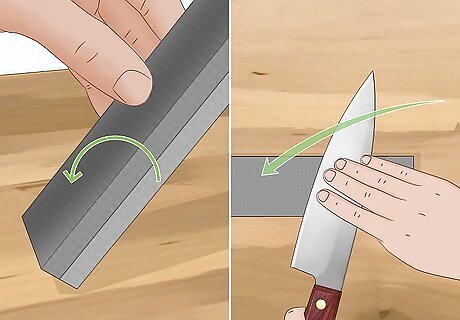
Flip the stone over, and repeat the previous 2 steps to polish the edge. Turn the stone over to the softer side, and then, applying softer pressure, draw the blade across as if you’re trying to slice into it. As you did with the coarse side of the stone, alternate between sides of the blade about 20 times. Your goal is to smooth over and eliminate the burrs created by sharpening the knife over the coarser grit. This transforms the blade from a ground edge into a finer, honed edge. The rough grit side of the stone is used to grind the steel down, while the fine grit side is used to sharpen or hone the knife.
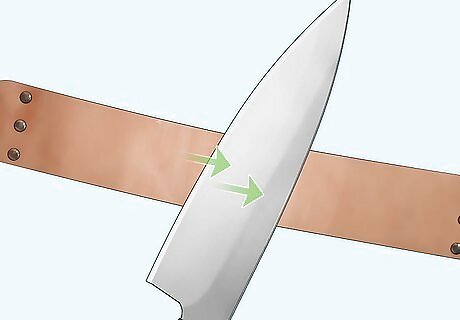
Further polish or strop the edge to the desired sharpness, if you want. Strop the blade by dragging the blade across a substrate—such as leather, paper, wood, or even the stone you’ve been using—in the opposite direction you’d drag it to slice (i.e., in the opposite direction you’ve been grinding it). This will help smooth out some of the burrs left by grinding. Stropping will make the edge better suited for "push cutting" (cutting directly into materials, pushing straight down without sliding the blade across the object) but may impair slicing ability: without the microscopic serrations left by grinding with a stone, the blade tends to not bite into things like tomato skins.
Using a Honing Rod (Sharpening Steel)
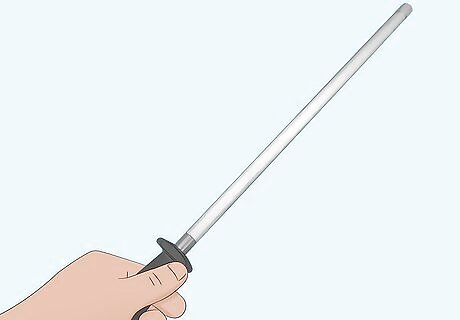
Hold the honing rod in your non-dominant hand with the rod facing away. Grip the handle, making sure to keep the rod at a comfortable angle facing away from your body. Keep the rod tip elevated above the rod handle. If you’re new to honing, consider placing the tip of the rod against the surface of a cutting board or work table for stability. It’s slower than holding the rod out in the air, but much easier.Sharpen a Knife Step 7Bullet1.jpg Honing and sharpening aren’t the same thing. A honing rod realigns the metal in a blade, massaging small nicks, indentations, and flat spots away. Using a honing rod regularly delays the need to use a whetstone. The less you use your whetstone, the longer your knives will thrive.
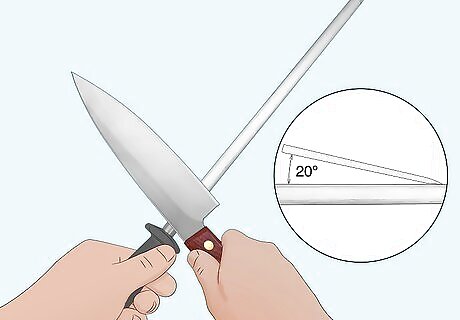
Use your other hand to position the blade against the rod at a 20° angle. Grip the handle firmly with the fingers of your dominant hand, and place your thumb on the spine of the knife, far away from the blade edge. Your angle doesn't need to be exact, just approximate. Make sure to maintain the same angle throughout the honing process. Changing the angle used during the honing process won't smooth out the metal in the blade as much as using a consistent angle will.
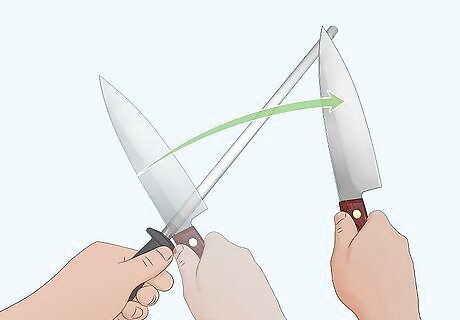
Draw the knife down the rod. Start this motion with the heel of the knife touching the rod and end it with the tip of the knife touching the rod. Drag the knife down blade-first, as if you are attempting to slice into the rod. Use only as much pressure as the weight of the knife itself. It's all in the wrist: without moving the wrist, you won't be able to sweep the entire blade—heel to tip—across the honing rod.
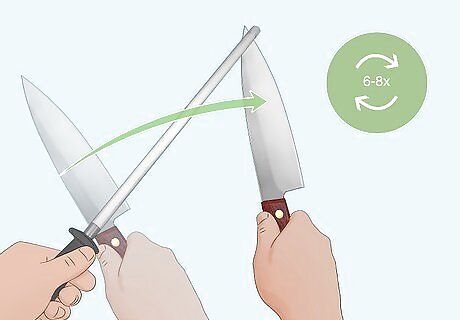
Alternate sides of the blade 6 to 8 times. This will ensure your blade is evenly honed. And voila! You’ve got a perfectly honed blade. After you’ve finished honing your blade, wipe it down or rinse it off to get rid of any lingering steel particles.
Using a Coffee Mug or Sandpaper

Lay sandpaper out flat, or place a mug upside down. If you're using sandpaper to sharpen your knife, pick the finest grit sandpaper you can and tape it flat on top of a cutting board or work table (or any surface you wouldn't mind damaging with your blade). You can also use a coffee mug: start by placing it upside down so that its coarse bottom is right-side up. If you want to sharpen your knife without any fancy equipment, a coffee mug can serve as a surprisingly effective sharpening tool in a pinch. The ceramic material of a mug is a material coarse enough to get good results. In fact, some honing rods even use ceramic material to keep a blade honed in between sharpenings! You can also lay your sandpaper down atop a mousepad, which will prevent it from slipping.

Sweep each blade edge across the grit 20 times at a 20° angle. Grind against the gritty bottom of the ceramic mug, or against your sandpaper. Be sure to hone each edge of the blade to ensure it sharpens evenly. Grind with the blade facing away from you, as if you’re trying to slice into the mug or sandpaper.
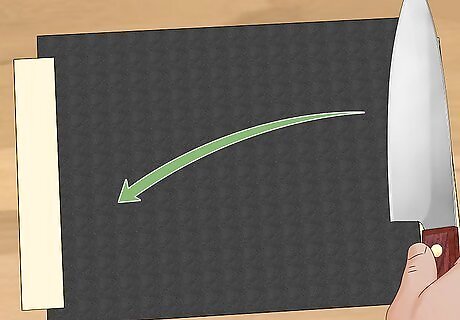
Do a few more sweeps, alternating between sides of the blade. Take one side of the blade and run it across the coffee mug or sandpaper, then turn the blade around and hit the opposite side. Repeat this pattern several times.
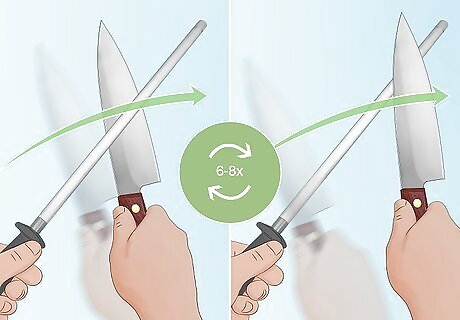
Swipe your blade across a honing rod 6 to 8 times, if you want. If you have a honing rod, using it to polish off your blade is a good way to end the sharpening process. Smooth out any burrs or kinks in the metal with several swipes on your trusty honing rod, and there! Your knife is sharp and ready to cut! During the grinding process, your blade likely formed some burrs—features that steel will automatically form when one bevel is ground until it meets another. Honing the blade will help relax the burrs, leaving the blade edge even sharper and more polished.











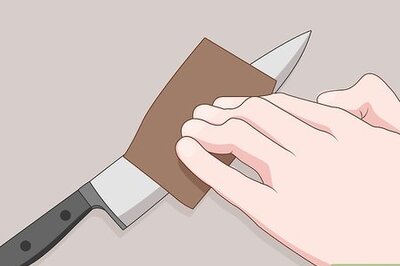
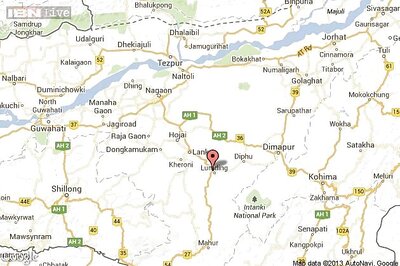






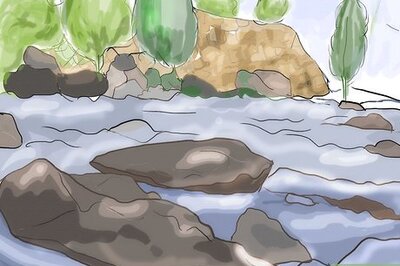
Comments
0 comment